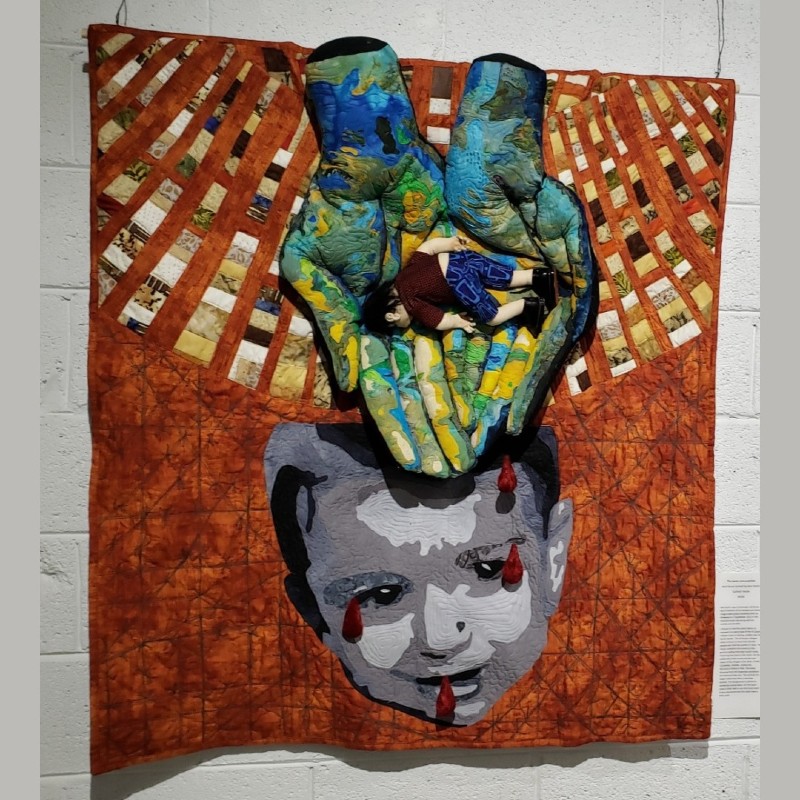Ram Jams: Evan Haywood's latest solo album is one of many new projects for this busy Ann Arbor creative

Evan Haywood's 2023 solo album, Elderberry Wine, is an engaging showcase for his craft as a songwriter and multi-instrumentalist. But that’s just the start of this Ann Arborite's growing creative ambitions, which have been on public display since Haywood joined the hip-hop group Tree City in 2006 when he was at Huron High School.
Elderberry Wine is a pleasure. Opening track “Peggy’s Farm” is good-time acoustic roots rock. Other tracks maintain a largely acoustic sound with a mellow, almost 1970s vibe. “Strands of Love” offers an engaging a cappella interlude, while the title track is an instrumental featuring a string section—one of the few instances on the record where Haywood didn’t play the instruments himself.
Beyond writing and performing, Haywood also operates a recording studio, Black Ram Treehouse, and his own record label, Black Ram Sound. He wants to branch out into clothing and merchandising as well. That sounds like a lot, which is partly why he recently left his “day job” in order to work on his creative pursuits as a full-time venture.
Haywood recently answered a few questions about his recent and upcoming projects.
Dig Deep: Sara Tea Reclaims Pieces From The Past on "Songs for Discarded Souls" EP

Sara Tea chronicles a cathartic journey of reclamation on Songs for Discarded Souls.
The Chelsea singer-songwriter / producer unearths past fears and forges a new path for the future on her debut EP.
“You get this recipe of thoughts, feelings, and sounds, and you don’t know the impact of it. We do what we have to survive, and it’s a luxury to reflect sometimes,” Tea said.
“We piece together the life we have to get where we have to. The moments that we can reclaim pieces of ourselves … I think there is healing that can come from that. I hope that we all in our own way can do that to the best of our ability.”
Tea suffers from postural orthostatic tachycardia syndrome (POTS) dysautonomia, which often begins after a major surgery, trauma, or a viral illness. It causes symptoms when you transition from lying down to standing up, such as a fast heart rate, dizziness, and fatigue, and creating Songs for Discarded Souls was one way she dealt with the symptoms.
Throughout the EP, Tea finds healing through five intimate tracks steeped in experimental soundscapes. Ethereal elements of ambient music, trip-hop, and indietronica seamlessly fuse with her lush vocals.
Big Picture: Ann Arbor songwriter Mark Zhu displays Confidence and Growth on recent Collaborative and Solo Releases

Mark Zhu presents a vivid picture on the song “paint the world red.”
The pop singer-songwriter worked with hip-hop / EDM producer Felix Lahann to showcase growth and determination on this empowering hip-hop anthem.
“By openly sharing our personal experiences, we gain a sense of catharsis and self-acceptance,” said Zhu, who graduated from Ann Arbor’s Skyline High School in June.
“It reminds us that we’re not alone in our struggles and that vulnerability can be a powerful tool for personal growth. Writing this track allowed us to express our vulnerabilities and showcase the strength that comes from embracing them.
“We wanted to create a song that could serve as a source of empowerment and encouragement for listeners, so the idea of ‘painting the world red’ represents how our music, ideas, and confidence is contagious enough to influence others.”
Golden Years: Purple Rose Theatre's "Jukebox for the Algonquin" focuses on seniors living and loving

Billed as “a serious comedy about sex, drugs, and rocking chairs,” Paul Stroili’s Jukebox for the Algonquin transpires at Placid Pines, a senior living community in the Adirondack region of New York, circa 2003.
This Purple Rose Theatre Company world premiere, which runs July 7-September 2, features characters who hail from the boroughs of New York City. They now find themselves removed from their usual surroundings and the people they loved, but they are ready to accept new challenges—even to create them.
Audiences may recognize playwright Stroili from his first-rate performances on the Rose stage—God of Carnage, Welcome to Paradise, and Watson in David MacGregor’s Sherlock Holmes series—or from TV appearances on Empire, Chicago P.D., Undercover Bridesmaid, and more.
Stroili says his venture into playwriting was “born of adversity.” He was booking roles in Los Angeles only sporadically and decided to write something for himself. Straight Up With a Twist enjoyed more than 1,000 performances nationwide and culminated in a twice-extended Off-Broadway run.
EMU professor Christine Hume faces “Everything I Never Wanted to Know” in her new book

“Do I even know one woman who hasn’t been subjected to male violence? Do you? Why doesn’t that admission stop us in our tracks?” asks EMU professor Christine Hume in her new essay collection, Everything I Never Wanted to Know.
Hume in turn does just that—she stops in her tracks to examine the violence and the imperfect structures meant to address it. She takes a critical lens to the ways that women’s bodies have been controlled through expressing productive outrage and through creating a mapping of this issue in our community. Her persistent questioning illuminates the injustices by compelling the reader to consider a response.
Take the National Sex Offender Registry: “Not a single man who has harassed or assaulted me or anyone I know is on that official list. How many men is that? How many men not on the registry does it take to make that registry itself an offense? How many men are we talking?” Hume accentuates the failings of a system that is supposed to contribute to safety. She goes on to scrutinize the laws that prevent offenders from living near a school or passing out Halloween candy, the design of the water tower in Ypsilanti, and a sexual assault case at Eastern Michigan University.
The essay “Icy Girls, Frigid Bitches, Frozen Dolls” looks at the implications of the once-popular Frozen Charlotte dolls in conjunction with a health issue that the author endures. Dolls in general are of interest, as Hume wonders, “What draws me to the doll is the vague but persistent sense of having lost my true and best self. A feeling of having once been more free, disciplined, attentive, athletic, daring, intelligent, and attractive.” The doll becomes a reflection of oneself:
Just like "Heaven": Kingfisher's confident and inventive widescreen debut LP balances intimate vocals and expansive instrumentation

For the past few years, Kingfisher has balanced college life with band life. But after the University of Michigan’s spring graduation, some members will head off to other Midwestern areas while others will stick around to complete their degrees.
The band might be closing a chapter but Kingfisher’s story will continue to unfold.
“The plan is to keep going,” said Sam DuBose (vocals, lyrics, guitar). “Things will definitely change. I mean, right now we’re all like three blocks from each other. But we had the conversation a while ago about what we were going to do, and all of us want to continue. We all love this group so much.”
Unlike most college bands though, Kingfisher isn’t fond of covers.
“We’ve actually never played a cover song at a show,” said Tyler Thenstedt (bass, vocals). “It’s been original music since the get-go. I would say that’s what people sort of know us for. A lot of Ann Arbor bands are incredible, but what sets us apart is that it has always been original music.”
Bold Ambition: Adam Labeaux Explores the Power of Courage and Vulnerability on “Brace Face” Album

Adam Labeaux searches for the true meaning of courage in himself and others on Brave Face.
The folk-rock singer-songwriter and multi-instrumentalist explores the power of tenacity, vulnerability, and authenticity on his latest album.
“It does have a lot to do with these central themes, and these are things I tend to touch on a lot, including the human condition,” said Labeaux, who resides in Ann Arbor.
“I tend to write dark folk, and I gravitate toward this subject matter and a focal point that maybe people don’t want to look at all the time. But I always have hope, and I always feel there's positivity to come out.”
That positivity and courage shine across Brave Face’s dozen tracks, which feature earnest lyrics, passionate vocals, and ‘70s-inspired folk-rock instrumentation flavored with jazz and soul. Imagine if Labeaux formed a new supergroup with members of the E Street Band, Steely Dan, and Toto.
“I’m the first to admit that sometimes I write songs to give myself words of encouragement that I’m not getting from someone else,” said Labeaux about his fourth album.
“If nothing else, I find that when I’m at my lowest and when I’m most manic that usually it means I haven’t been writing enough. I haven’t been expressing it, and I really need to get into that space and have that cathartic moment.”
Gutman Gallery’s “Every Body” Exhibition Offers an Engaging Exploration of Diversity

The Every Body exhibition currently on display at Ann Arbor's Gutman Gallery showcases both the variety of the human form and the artwork that honors it.
Running through July 1, the all-media show features 34 works by 27 artists in the Guild of Artists and Artisans’ storefront space. Built on a theme of “figurative artwork and body diversity,” the exhibit succeeds in offering an engaging mix of media, artistic styles, and subject matter.
A number of the works in the exhibition feature artist statements, often with compelling stories that provide depth. For example, April Shipp’s mixed-media piece The water returned Him is one of the more visually striking pieces in the exhibit, yet knowing the background of the global refugee crises and the story of one particular child who inspired it. Likewise, Jensen Ellington’s My Piece of Eden creatively combines fabric, tree limbs, and thread to connect the Biblical story of Adam’s rib to his own experience as a transgender man. Other pieces stand on their own, such as E. Ingrid Tietz’s elegant Porcelain Muses V which lets her subjects speak to each viewer individually.
Any visitor to the exhibit is likely to come away with a renewed appreciation of the diversity of the human form as well as of the artists and artworks that celebrate it. Noted local artist Nora Venturelli juried the exhibition, and she agreed to answer a few questions about it:
Capturing the Cosmos: Jason Guenzel photographs the beauty of space from Earth

Jason Guenzel has a passion for exploring the cosmos with his camera.
The Michigan-based astrophotographer will appear at the Ann Arbor District Library's Downtown location at 7 pm on June 29 to discuss his love of astrophotography. Guenzel will talk about his journey to the stars, the equipment he uses, and how you can get started in this discipline, which mixes science and art. He'll also present many of his fascinating photos of the cosmos, explaining the specialized techniques he used to capture these breathtaking images.
I spoke with Guenzel ahead of his AADL appearance.
Follow the Reindeer: Hanna Pylväinen's novel tracks missionaries and herders living on the Scandinavian tundra in 1851

How do you know when an action is a mistake or a choice?
This distinction is the question and crux of many turning points in The End of Drum-Time by U-M alum Hanna Pylväinen.
As character Risten Tomma reflects on her decision to marry Mikkol:
But was that all it was, then? You said a thing and then it all changed, you lived with another man now, someone else came into your lávvu and slept with you across the fire from your parents. There would be a new dog, and even their dogs would have to learn to get along.
Some changes are anticlimactic, while other changes are catastrophic.
The sweeping, well-paced novel is set in 1851 in the Scandinavian tundra with missionaries and reindeer herders both vying for their ways of life. Another one of the main characters, Willa, the daughter of the pastor Lars Levi Laestadius, faces numerous life-altering decisions over the course of the book. Early on "she was a kettle left at a gentle boil, and with her heat she did nothing more than make coffee or tea.” Yet, when she starts encountering Ivvár Rasti on her walks, a stronger wave begins to roil in her for him, despite the fact that he calls her “a good little báhpa nieida, good little church-girl.”
Willa steps deeper and deeper into an irreversible series of events in which:


































